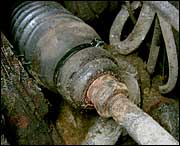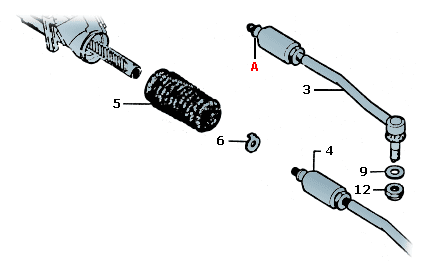|
 Every time you change between summer- and winter-tires,
or you think something is wrong with the steering:
Every time you change between summer- and winter-tires,
or you think something is wrong with the steering:
With the wheel off the ground; twist it from side to side with your hands
and observe if the relay bar (3)
moves in and out of the rod ball joint. It shall move a little (it has got a small damping),
but not much.
If it moves a lot, or you hear a clicking sound, the rod ball joint must be replaced immediately.
|
|
|
Replacement of the rod ball joint
 The drawing is borrowed from the Citroën CX' parts list
The drawing is borrowed from the Citroën CX' parts list

- Jack up the front of the car and put it on safety stands.
- Remove the road wheel.
- Turn the steering-wheel all the way to the opposite side, turn off the ignition and
remove the key to activate the key lock.
- Remove pressure on the hydraulic system (open
the bleed screw
).
- Unscrew the nut (12).
- Clean, then cut the plastic strips and push the bellows (5) all the way in.
- Bend open the ball head lock (6).
- Use a short 17mm wrench and unscrew the rod ball joint where it is attached to the steering rack (A).
- Remove the relay bar (3) and put it in a vice.
- Mark the exact placement of the nut.
- Replace the rod ball joint (check that the new rod ball joint has the same length).
Assembly:
Use nut "glue" and
bend the ball head lock (preferably new)
properly in place.
Get the front suspension/steering checked or
try to do it yourself.
|
|

• The rod ball joint
(4) exist in 2 lengths, and so do the relay bar
(you therefore must have short
rod ball joint + long relay bar, or vice versa).
• Sloppy steering can be caused by worn out rod ball joints (4) or that the ball head lock
(6) has failed, causing the rod ball joint to unscrewing itself.
Use 8 mm and 19 mm wrench to loosen the nut (12) (as seen from underneath).
|
|

